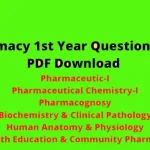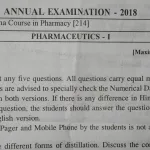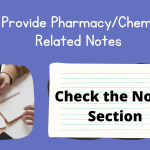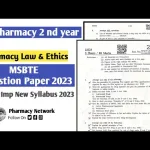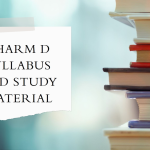D Pharmacy previous year question papers provide an essential resource for students looking to prepare effectively for their exams. By reviewing past papers, students can familiarize themselves with the exam format, important topics, and commonly asked questions, boosting their confidence and knowledge for better performance.
Pharmaceutical Chemistry I
Question: What is the classification of drugs based on their chemical structure?
Answer: Drugs can be classified based on their chemical structure into various categories such as alkaloids, steroids, terpenes, and peptides.
Question: Define the term “pharmacokinetics.”
Answer: Pharmacokinetics refers to the study of the absorption, distribution, metabolism, and excretion of drugs in the body.
Question: Explain the significance of pH in drug formulation.
Answer: The pH of a drug formulation affects the solubility, stability, and bioavailability of the drug.
Question: What are the different methods of drug absorption?
Answer: Drugs are absorbed through various routes including oral, intravenous, intramuscular, subcutaneous, and transdermal.
Question: Discuss the concept of first-pass metabolism.
Answer: First-pass metabolism refers to the initial metabolism of a drug by the liver before it reaches systemic circulation.
Question: What are prodrugs and how do they work?
Answer: Prodrugs are inactive compounds that undergo biotransformation in the body to release the active drug.
Question: Define bioavailability.
Answer: Bioavailability is the fraction of an administered dose of a drug that reaches the systemic circulation in an active form.
Question: What are the factors affecting drug absorption?
Answer: Factors include the drug’s solubility, dosage form, route of administration, and the presence of food in the stomach.
Question: What are the common routes of drug administration?
Answer: Common routes include oral, intravenous, sublingual, intramuscular, and topical.
Question: Describe the importance of drug stability in formulation.
Answer: Drug stability ensures that the drug retains its efficacy, safety, and quality throughout its shelf life.
Question: What is the role of excipients in pharmaceutical formulations?
Answer: Excipients are inactive substances used in drug formulations to aid in drug stability, absorption, and delivery.
Question: Explain the difference between active and inactive pharmaceutical ingredients.
Answer: Active ingredients produce the therapeutic effect, while inactive ingredients aid in the formulation, stability, and delivery of the drug.
Question: What are the various types of pharmaceutical dosage forms?
Answer: These include tablets, capsules, injections, syrups, creams, and suppositories.
Question: How do you calculate the half-life of a drug?
Answer: Half-life is calculated using the formula t1/2 = 0.693 × (Vd / Cl), where Vd is volume of distribution and Cl is clearance.
Question: What is the significance of the therapeutic index of a drug?
Answer: The therapeutic index measures the safety margin of a drug, indicating the difference between the effective dose and the toxic dose.
Question: Discuss the concept of drug tolerance.
Answer: Drug tolerance occurs when a person requires increasing doses of a drug to achieve the same therapeutic effect.
Question: What are the different types of drug interactions?
Answer: Drug interactions can be pharmacodynamic, pharmacokinetic, or drug-disease interactions, affecting efficacy and safety.
Question: How does protein binding affect drug distribution?
Answer: Protein binding affects the amount of free drug available for distribution, metabolism, and excretion.
Question: What is the significance of drug clearance?
Answer: Drug clearance is the volume of plasma from which a drug is completely removed per unit time, indicating how quickly the body eliminates the drug.
Pharmacognosy
Question: What is the importance of herbal drugs in modern medicine?
Answer: Herbal drugs have therapeutic properties and are used for the treatment of various ailments, often with fewer side effects than synthetic drugs.
Question: Define the term “pharmacognosy.”
Answer: Pharmacognosy is the study of drugs derived from natural sources such as plants, animals, and minerals.
Question: What are the major classes of plant constituents used in medicinal preparations?
Answer: These include alkaloids, glycosides, terpenoids, flavonoids, and essential oils.
Question: Explain the difference between primary and secondary metabolites in plants.
Answer: Primary metabolites are essential for growth, such as carbohydrates and proteins, while secondary metabolites have medicinal properties and are not directly involved in growth.
Question: What is the role of alkaloids in pharmacognosy?
Answer: Alkaloids are nitrogen-containing compounds known for their pharmacological effects, such as analgesic and anti-inflammatory properties.
Question: Describe the uses of essential oils in pharmaceutical preparations.
Answer: Essential oils are used for their antimicrobial, anti-inflammatory, and aromatic properties in medicinal and cosmetic formulations.
Question: What is the significance of glycosides in medicinal plants?
Answer: Glycosides have various therapeutic effects, including cardiac, diuretic, and antidiabetic properties.
Question: What are the methods used for the extraction of plant drugs?
Answer: Common extraction methods include maceration, percolation, infusion, and distillation.
Question: Explain the concept of standardization in herbal medicines.
Answer: Standardization ensures that the quality, potency, and purity of herbal products remain consistent from batch to batch.
Question: How do flavonoids contribute to human health?
Answer: Flavonoids are antioxidants with anti-inflammatory, anticancer, and cardiovascular protective properties.
Question: What is the difference between crude drugs and processed drugs?
Answer: Crude drugs are plant or animal materials in their natural form, while processed drugs are refined and standardized for medicinal use.
Question: What are the factors that affect the quality of herbal drugs?
Answer: Factors include the plant’s source, harvesting time, method of processing, and storage conditions.
Question: What is the role of resins in pharmacognosy?
Answer: Resins have antimicrobial and anti-inflammatory properties and are used in the treatment of respiratory and digestive disorders.
Question: Define the term “herbal medicine.”
Answer: Herbal medicine involves the use of plant-based materials for therapeutic purposes, either as whole plants or in extracts.
Question: What is the pharmacological action of tannins?
Answer: Tannins have astringent properties and are used for their antimicrobial and anti-inflammatory effects.
Question: Describe the various methods of determining the quality of crude drugs.
Answer: Methods include organoleptic evaluation, microscopic examination, physical testing, and chemical analysis.
Question: What is the significance of pharmacognosy in drug discovery?
Answer: Pharmacognosy plays a crucial role in discovering new drugs from natural sources and developing safer, more effective medicines.
Question: How are alkaloids extracted from plant sources?
Answer: Alkaloids are extracted using solvents such as alcohol, chloroform, or ether through processes like maceration or Soxhlet extraction.
Question: What are the therapeutic uses of anthraquinone glycosides?
Answer: Anthraquinone glycosides are commonly used as laxatives and possess antimicrobial properties.
Question: How do saponins benefit human health?
Answer: Saponins have anti-inflammatory, antidiabetic, and immune-boosting properties.
Pharmaceutical Microbiology
Question: What is the role of microbiology in pharmacy?
Answer: Microbiology is crucial for understanding microbial contamination in drugs, formulating antiseptic products, and ensuring the safety of pharmaceutical products.
Question: What are the different types of microorganisms?
Answer: Microorganisms include bacteria, fungi, viruses, protozoa, and algae.
Question: Define sterility in the context of pharmaceutical products.
Answer: Sterility refers to the complete absence of viable microorganisms in a product, ensuring it is free from contamination.
Question: How are microorganisms identified in the laboratory?
Answer: Microorganisms are identified using techniques like staining, culturing, biochemical tests, and molecular methods.
Question: What is the significance of antimicrobial testing?
Answer: Antimicrobial testing determines the effectiveness of drugs in inhibiting or killing harmful microorganisms.
Question: What are the common methods of sterilization used in the pharmaceutical industry?
Answer: Methods include steam sterilization, dry heat, filtration, and radiation.
Question: Explain the difference between bactericidal and bacteriostatic drugs.
Answer: Bactericidal drugs kill bacteria, while bacteriostatic drugs inhibit the growth of bacteria without killing them.
Question: What are the factors that influence the growth of microorganisms?
Answer: Factors include temperature, pH, nutrient availability, and oxygen levels.
Question: How do antibiotics work to inhibit bacterial growth?
Answer: Antibiotics work by disrupting essential bacterial processes, such as cell wall synthesis, protein synthesis, and DNA replication.
Question: What is an antibiotic resistance mechanism?
Answer: Antibiotic resistance occurs when bacteria develop mechanisms to survive exposure to antibiotics, such as altering drug targets or producing enzymes that inactivate drugs.
Question: What is the role of the immune system in preventing infections?
Answer: The immune system defends the body against pathogens by recognizing and destroying harmful microorganisms.
Question: What are the different methods used for testing microbial contamination in pharmaceuticals?
Answer: Methods include the plate count method, membrane filtration, and the most probable number method.
Question: How do vaccines help in the prevention of diseases?
Answer: Vaccines stimulate the immune system to produce antibodies and memory cells, providing immunity against specific diseases.
Question: What is the importance of quality control in pharmaceutical microbiology?
Answer: Quality control ensures that pharmaceutical products are free from harmful microorganisms and meet safety and efficacy standards.
Question: What are some common microbial contamination sources in drug manufacturing?
Answer: Sources include raw materials, equipment, personnel, and the manufacturing environment.
Question: Describe the process of endotoxin testing.
Answer: Endotoxin testing is performed to detect bacterial endotoxins that could cause harm when introduced into the body.
Question: What is the role of fungi in pharmaceutical products?
Answer: Fungi can be used in the production of antibiotics, enzymes, and other therapeutic agents, but they may also cause contamination in products.
Question: What is the significance of microbial limits testing?
Answer: Microbial limits testing ensures that pharmaceutical products contain no harmful levels of microorganisms, maintaining their safety and effectiveness.
Question: Define the term “bioburden.”
Answer: Bioburden refers to the number of viable microorganisms present in a pharmaceutical product before sterilization.
Question: How do you interpret the results of antimicrobial susceptibility testing?
Answer: Results are interpreted by measuring the inhibition zones around antibiotic discs and determining whether the bacteria are resistant, susceptible, or intermediate.
Studying previous year question papers of D Pharmacy can significantly help students in understanding exam patterns and important topics. By practicing these questions, students gain better clarity and can improve their overall performance, ensuring they are well-prepared for their exams.
Latest Posts
- Step-by-step guide to download and apply for jee mains admit card 202
- Comprehensive 2025 government holidays and recruitment details for job seekers
- JEE Mains Admit Card 2025: Your Step-by-Step Guide to Downloading the Hall Ticket
- Everything You Need to Know About 2025 Government Holidays Recruitment
- Comprehensive Guide to rrb d group recruitment 2025 – Eligibility, Vacancies, and Application
- Detailed guide to nps trust recruitment 2025 vacancies, eligibility and apply process
- Comprehensive guide to hpcl recruitment 2025 notification, vacancies, and application process
- ignou bed admission 2025 complete recruitment guide with eligibility and process
- Comprehensive Guide to Indian Army Agniveer Recruitment 2025 Notification and Jobs
- Everything You Must Know About CBSE Board Exams 2025 Changes & New Rules


